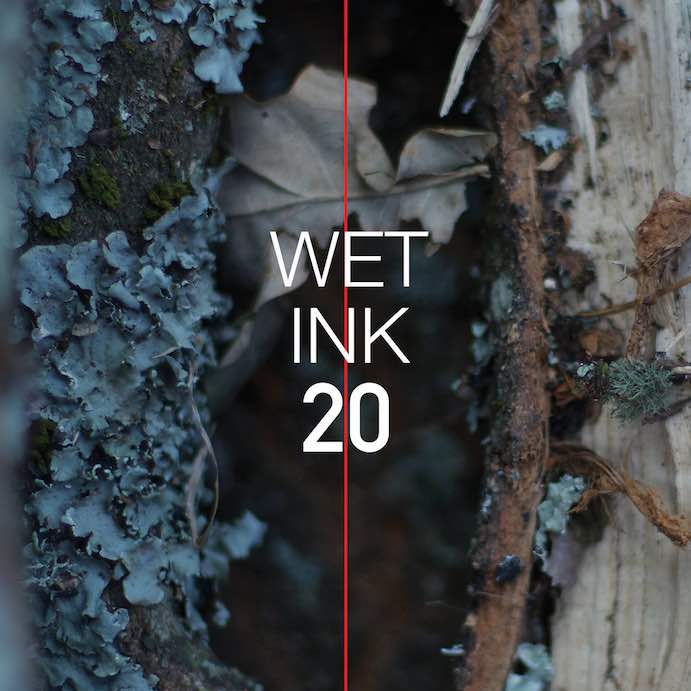Named the Best Ensemble of 2018 by the New York Times, Wet Ink Ensemble has been having a year of celebration and reminiscence in honor of their twentieth anniversary, including the release of their brilliant album Wet Ink 20. Released on Carrier Records, Wet Ink 20 features works by Eric Wubbels, Katherine Young, Sam Pluta, Anthony Braxton, Kate Soper, and Alex Mincek, with beautifully-designed cover art by Angela Guyton. The sense of camaraderie and respect that these creative people have for each other is something that is perceptible throughout the recording. Good things come with patience and arduous labor, and Wet Ink has created a space for musicians to gather and explore, which reveals an incredible musical world worth listening to over, and over, and over again.
Wet Ink 20 opens with Eric Wubbels’ Auditory Scene Analysis, Part I (2014) for 18 players, narrator, and electronic sound, featuring Erin Lesser on flute and narration by Kate Soper. The piece opens with a fast flurry of solo flute, combining registral extremes in a great variety of textures that are suddenly (and almost comically) interrupted by white noise. Lesser molds the sounds of the flute into whatever she wants it to be in this humorous, sneaky, groovy, and remotely ASMR-ish work. Soper’s voice is direct and easy to listen to–she talks about chimeras, and the words melt away in the incredible world of sound that the composer has created.
Wet Ink Ensemble
Katherine Young’s like a halo (2014) offers an alluringly creepy and disturbing atmosphere that is suspenseful and comforting at the same time. Young creates this environment by combining soft and articulated breath sounds from the voice, with slow, chocking whispers from the violin. like a halo features Josh Modney on prepared violin, achieved by detuning the instrument and using a very slow bow technique. His control and precision are outstanding, and the quality of his sound is awe-inspiring.
Sam Pluta’s Portraits/Self-Portraits (2011) is described as a “re-imagining and re-orchestration of the sounds and processes found on Sum and Difference,” Pluta’s 2010 improvised album with Peter Evans and Jem Altieri. A cloud of slap-tongue, harmonics, and sharp percussion interference kick off this fascinating piece for solo violin (Modney) and large ensemble. Understanding that the piece draws inspirations from improvisation is paramount. The musicians show that they have a level of sensitivity and awareness that can only come from players that are true masters of their craft.
Anthony Braxton’s Composition No. 56 (1976) presents a confrontation of jazzy pizzicatos and voice-like moans from the bass, supported by a foundation of scratchy electronics. The piece is written for “creative orchestra”–what a beautiful way to describe what is going on in this piece. Braxton’s work is a combination of composition and improvisation that gives the musicians ample space to use their creative powers, delivering a final product that is daring, playful, and vibrant.
Anthony Braxton
Kate Soper‘s The Ultimate Poem is Abstract (2016, rev. 2017) sets texts by Wallace Stevens with hypnotizing beats and waves of microtonality. The resulting lush and full sounds build a great base for Soper’s beautiful voice. Wet Ink 20 ends with Alex Mincek’s Chamber Concerto (2013), originally commissioned by the French Ministry of Culture for Ensemble Linea to be paired with Ligeti’s Kammerkonzert. Mincek employs perhaps the most academic language in the album, asking the listener to intensely pay attention to all of the different voices and textures that occur throughout its four movements. Wet Ink Ensemble shares their take on this demanding piece with intense sensitivity and virtuosity.
Ryan Streber’s recording work, Sam Pluta’s mixing, Matt Mehlan’s mastering, along with the performance work of the members of Wet Ink Ensemble display humanity, honesty, and outstanding musicianship throughout Wet Ink 20. The album is a truly wonderful celebration of twenty years of hard work and stellar music making.

